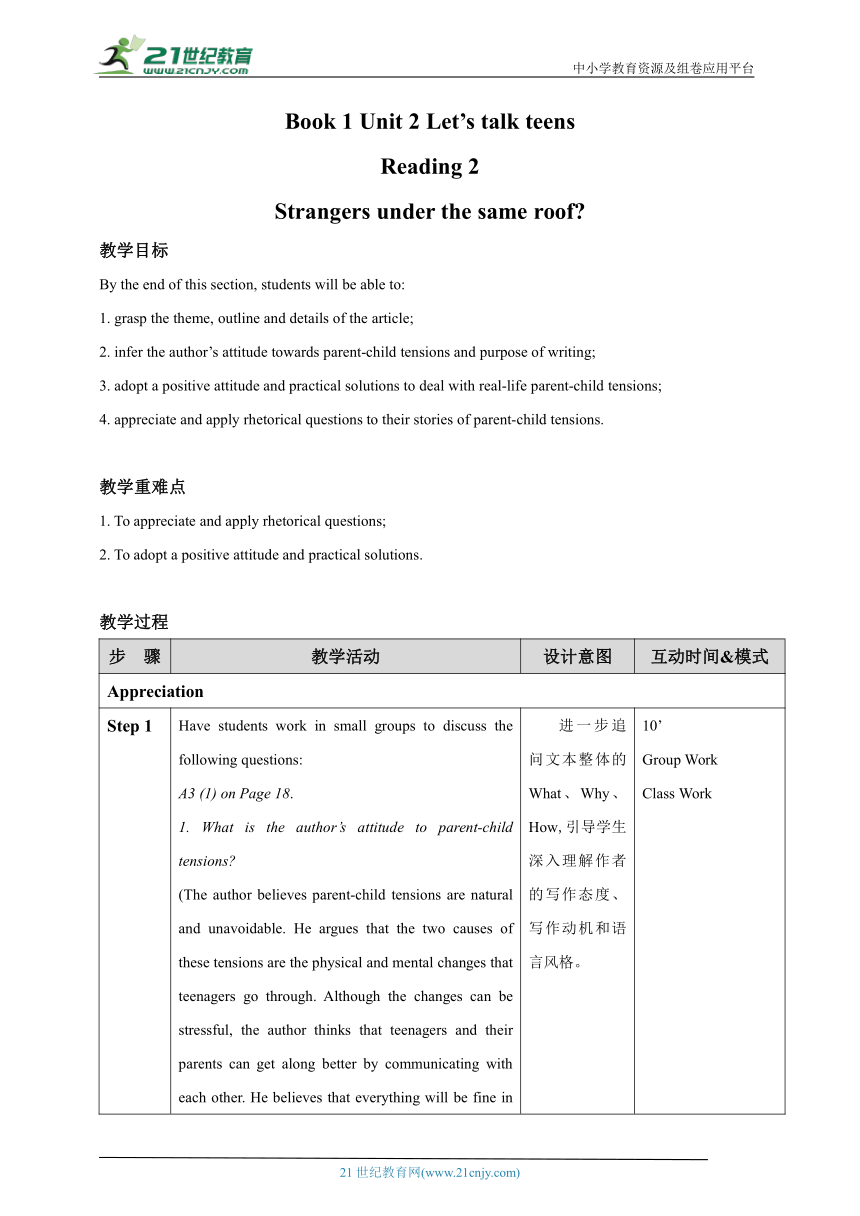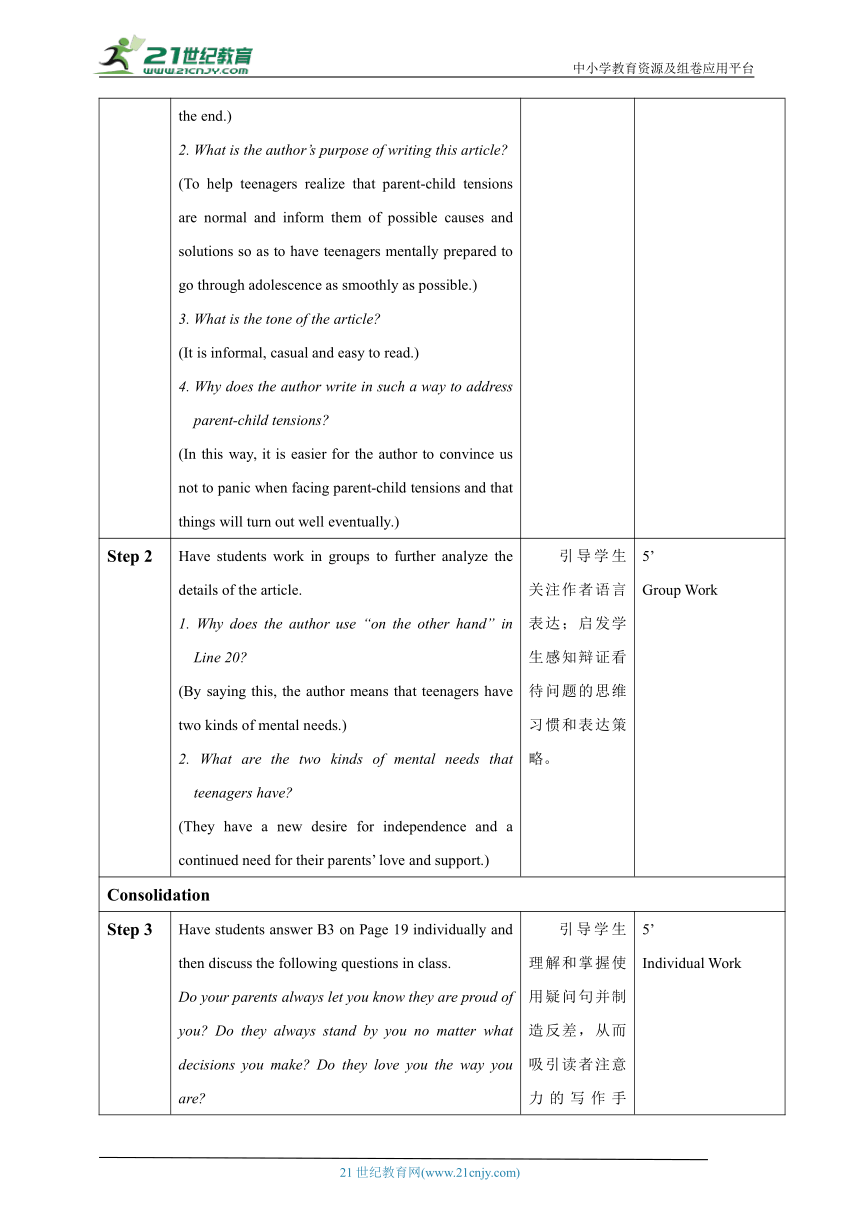Unit 2 Let's talk teens_Reading_2 教案
文档属性
| 名称 | Unit 2 Let's talk teens_Reading_2 教案 |

|
|
| 格式 | doc | ||
| 文件大小 | 45.5KB | ||
| 资源类型 | 试卷 | ||
| 版本资源 | 牛津译林版(2019) | ||
| 科目 | 英语 | ||
| 更新时间 | 2022-09-23 08:41:11 | ||
图片预览


文档简介
中小学教育资源及组卷应用平台
Book 1 Unit 2 Let’s talk teens
Reading 2
Strangers under the same roof
教学目标
By the end of this section, students will be able to:
1. grasp the theme, outline and details of the article;
2. infer the author’s attitude towards parent-child tensions and purpose of writing;
3. adopt a positive attitude and practical solutions to deal with real-life parent-child tensions;
4. appreciate and apply rhetorical questions to their stories of parent-child tensions.
教学重难点
1. To appreciate and apply rhetorical questions;
2. To adopt a positive attitude and practical solutions.
教学过程
步 骤 教学活动 设计意图 互动时间&模式
Appreciation
Step 1 Have students work in small groups to discuss the following questions: A3 (1) on Page 18. 1. What is the author’s attitude to parent-child tensions (The author believes parent-child tensions are natural and unavoidable. He argues that the two causes of these tensions are the physical and mental changes that teenagers go through. Although the changes can be stressful, the author thinks that teenagers and their parents can get along better by communicating with each other. He believes that everything will be fine in the end.) 2. What is the author’s purpose of writing this article (To help teenagers realize that parent-child tensions are normal and inform them of possible causes and solutions so as to have teenagers mentally prepared to go through adolescence as smoothly as possible.) 3. What is the tone of the article (It is informal, casual and easy to read.) 4. Why does the author write in such a way to address parent-child tensions (In this way, it is easier for the author to convince us not to panic when facing parent-child tensions and that things will turn out well eventually.) 进一步追问文本整体的What、Why、How,引导学生深入理解作者的写作态度、写作动机和语言风格。 10’ Group Work Class Work
Step 2 Have students work in groups to further analyze the details of the article. 1. Why does the author use “on the other hand” in Line 20 (By saying this, the author means that teenagers have two kinds of mental needs.) 2. What are the two kinds of mental needs that teenagers have (They have a new desire for independence and a continued need for their parents’ love and support.) 引导学生关注作者语言表达;启发学生感知辩证看待问题的思维习惯和表达策略。 5’ Group Work
Consolidation
Step 3 Have students answer B3 on Page 19 individually and then discuss the following questions in class. Do your parents always let you know they are proud of you Do they always stand by you no matter what decisions you make Do they love you the way you are Can we start the article with a group of declarative sentences instead of questions Which way is better and why (We can do so but I believe it is better to start the article with questions. Not only are we attracted to the article, but we are more willing to take in the arguments put forward by the author.) 引导学生理解和掌握使用疑问句并制造反差,从而吸引读者注意力的写作手法。 5’ Individual Work
Application
Step 4 Have students practice the use of new words and phrases, and finish B1 on Page 19 and a related task individually. Task: If you were the editor, how would you reply to the mom (范文见课件Page 8) 帮助学生进一步掌握、巩固在语境中运用文本所学词汇的能力;创设回信语境,在语境中拓展话题相关词汇,为本节课最后的写作活动热身。 8’ Individual Work Class Work
Extension
Step 5 Have students use rhetorical questions to complete the following activity. Have you ever had a conflict with your parents First fill in the following table and then write a 150-word episode of one conflict with your parents. Try to add a unique title and begin the story with rhetorical questions to keep readers interested. (表格和范文见课件Pages 10–12) 引导学生运用使用疑问句并制造反差,从而吸引读者注意力的写作手法;运用文本所学词汇和语句,培养学生相关主题语境的书面表达能力;在真实情境中培养学生解决实际问题的能力。 15’ Individual Work Class Work
Homework 1. Finish B1 and B2 on Page 19. 2. Finish the workbook. 3. Perfect the writing in Step 5. 2’
21世纪教育网 www.21cnjy.com 精品试卷·第 2 页 (共 2 页)
21世纪教育网(www.21cnjy.com)
Book 1 Unit 2 Let’s talk teens
Reading 2
Strangers under the same roof
教学目标
By the end of this section, students will be able to:
1. grasp the theme, outline and details of the article;
2. infer the author’s attitude towards parent-child tensions and purpose of writing;
3. adopt a positive attitude and practical solutions to deal with real-life parent-child tensions;
4. appreciate and apply rhetorical questions to their stories of parent-child tensions.
教学重难点
1. To appreciate and apply rhetorical questions;
2. To adopt a positive attitude and practical solutions.
教学过程
步 骤 教学活动 设计意图 互动时间&模式
Appreciation
Step 1 Have students work in small groups to discuss the following questions: A3 (1) on Page 18. 1. What is the author’s attitude to parent-child tensions (The author believes parent-child tensions are natural and unavoidable. He argues that the two causes of these tensions are the physical and mental changes that teenagers go through. Although the changes can be stressful, the author thinks that teenagers and their parents can get along better by communicating with each other. He believes that everything will be fine in the end.) 2. What is the author’s purpose of writing this article (To help teenagers realize that parent-child tensions are normal and inform them of possible causes and solutions so as to have teenagers mentally prepared to go through adolescence as smoothly as possible.) 3. What is the tone of the article (It is informal, casual and easy to read.) 4. Why does the author write in such a way to address parent-child tensions (In this way, it is easier for the author to convince us not to panic when facing parent-child tensions and that things will turn out well eventually.) 进一步追问文本整体的What、Why、How,引导学生深入理解作者的写作态度、写作动机和语言风格。 10’ Group Work Class Work
Step 2 Have students work in groups to further analyze the details of the article. 1. Why does the author use “on the other hand” in Line 20 (By saying this, the author means that teenagers have two kinds of mental needs.) 2. What are the two kinds of mental needs that teenagers have (They have a new desire for independence and a continued need for their parents’ love and support.) 引导学生关注作者语言表达;启发学生感知辩证看待问题的思维习惯和表达策略。 5’ Group Work
Consolidation
Step 3 Have students answer B3 on Page 19 individually and then discuss the following questions in class. Do your parents always let you know they are proud of you Do they always stand by you no matter what decisions you make Do they love you the way you are Can we start the article with a group of declarative sentences instead of questions Which way is better and why (We can do so but I believe it is better to start the article with questions. Not only are we attracted to the article, but we are more willing to take in the arguments put forward by the author.) 引导学生理解和掌握使用疑问句并制造反差,从而吸引读者注意力的写作手法。 5’ Individual Work
Application
Step 4 Have students practice the use of new words and phrases, and finish B1 on Page 19 and a related task individually. Task: If you were the editor, how would you reply to the mom (范文见课件Page 8) 帮助学生进一步掌握、巩固在语境中运用文本所学词汇的能力;创设回信语境,在语境中拓展话题相关词汇,为本节课最后的写作活动热身。 8’ Individual Work Class Work
Extension
Step 5 Have students use rhetorical questions to complete the following activity. Have you ever had a conflict with your parents First fill in the following table and then write a 150-word episode of one conflict with your parents. Try to add a unique title and begin the story with rhetorical questions to keep readers interested. (表格和范文见课件Pages 10–12) 引导学生运用使用疑问句并制造反差,从而吸引读者注意力的写作手法;运用文本所学词汇和语句,培养学生相关主题语境的书面表达能力;在真实情境中培养学生解决实际问题的能力。 15’ Individual Work Class Work
Homework 1. Finish B1 and B2 on Page 19. 2. Finish the workbook. 3. Perfect the writing in Step 5. 2’
21世纪教育网 www.21cnjy.com 精品试卷·第 2 页 (共 2 页)
21世纪教育网(www.21cnjy.com)
